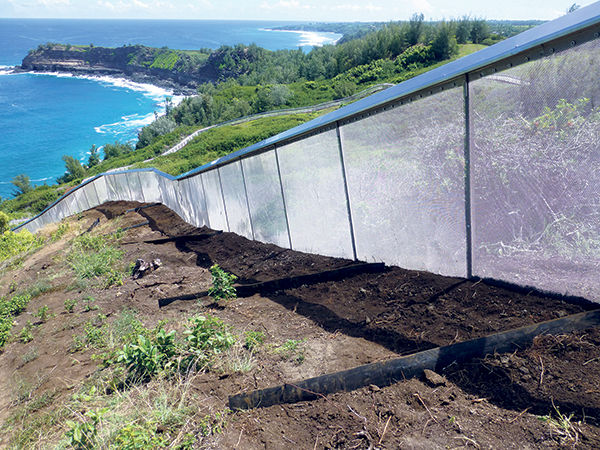LIHUE — The predator-proof fence is up. Now, it’s a matter of removing the predators. Rare native plant and animal communities that have inhabited a roughly eight-acre area at the Kilauea Point National Wildlife Refuge — including imperiled bird species
LIHUE — The predator-proof fence is up.
Now, it’s a matter of removing the predators.
Rare native plant and animal communities that have inhabited a roughly eight-acre area at the Kilauea Point National Wildlife Refuge — including imperiled bird species found nowhere else on Earth — will be protected following the installation of the state-of-the-art fence east of the lighthouse.
The half-mile fence, similar to the one found at Kaena Point on Oahu, took about three months to construct and will keep introduced mammalian predators, including cats, dogs, rats and mice, out of the area so that native species such as the endangered Nene (Hawaiian Goose), the Moli (Laysan Albatross) and rare plants can flourish again in a protected environment.
In addition, the absence of introduced predators make this restored site an appropriate translocation site for the threatened Ao (Newell’s Shearwater) and for the reintroduction of rare native plants.
“Predator-proof fencing is a conservation strategy that we are going to see used more and more in Hawaii as we struggle to deal with widespread non-native predator populations on very large islands,” said George Wallace, vice president of American Bird Conservancy.
The type of fencing has been used with success in other areas, such as New Zealand and at Kaena Point, where predator exclusion resulted in record numbers of seabird chicks fledging in the year immediately following the project’s completion.
“To have planned, broken ground, and finished construction in a two-year timeframe is a phenomenal success and an incredible accomplishment that our partners, ABC and Pacific Rim Conservation, have made possible,” said Shannon Smith, U.S. Fish and Wildlife Service project leader.
The planned translocation of Newell’s Shearwater is an important aspect of the Kauai project.
“We have seen a dramatic decline in the population of Newell’s Shearwater in recent years due to a range of issues, with an estimated 75 percent decline in the last 15 years,” said Dr. André Raine of the Kauai Endangered Seabird Recovery Project. “The establishment of a new colony using predator-proof fences is an important management tool to help reverse this decline.”
The fence is about 6.5 feet tall and is built entirely of stainless steel to resist the harsh marine environment. The main panels of the fence are made with mesh so fine that even mammals as small as a two-day-old mouse cannot enter. The top of the fence has an arched hood that extends outward to prevent animals from climbing over.
With the fence in place, work can begin to humanely remove non-native predators from the enclosure and restore native plant communities.
The $500,000 project is a collaboration between the U.S. Fish and Wildlife Service, the National Fish and Wildlife Foundation, the American Bird Conservancy, the Kauai Endangered Seabird Recovery Project and Pacific Rim Conservation.


